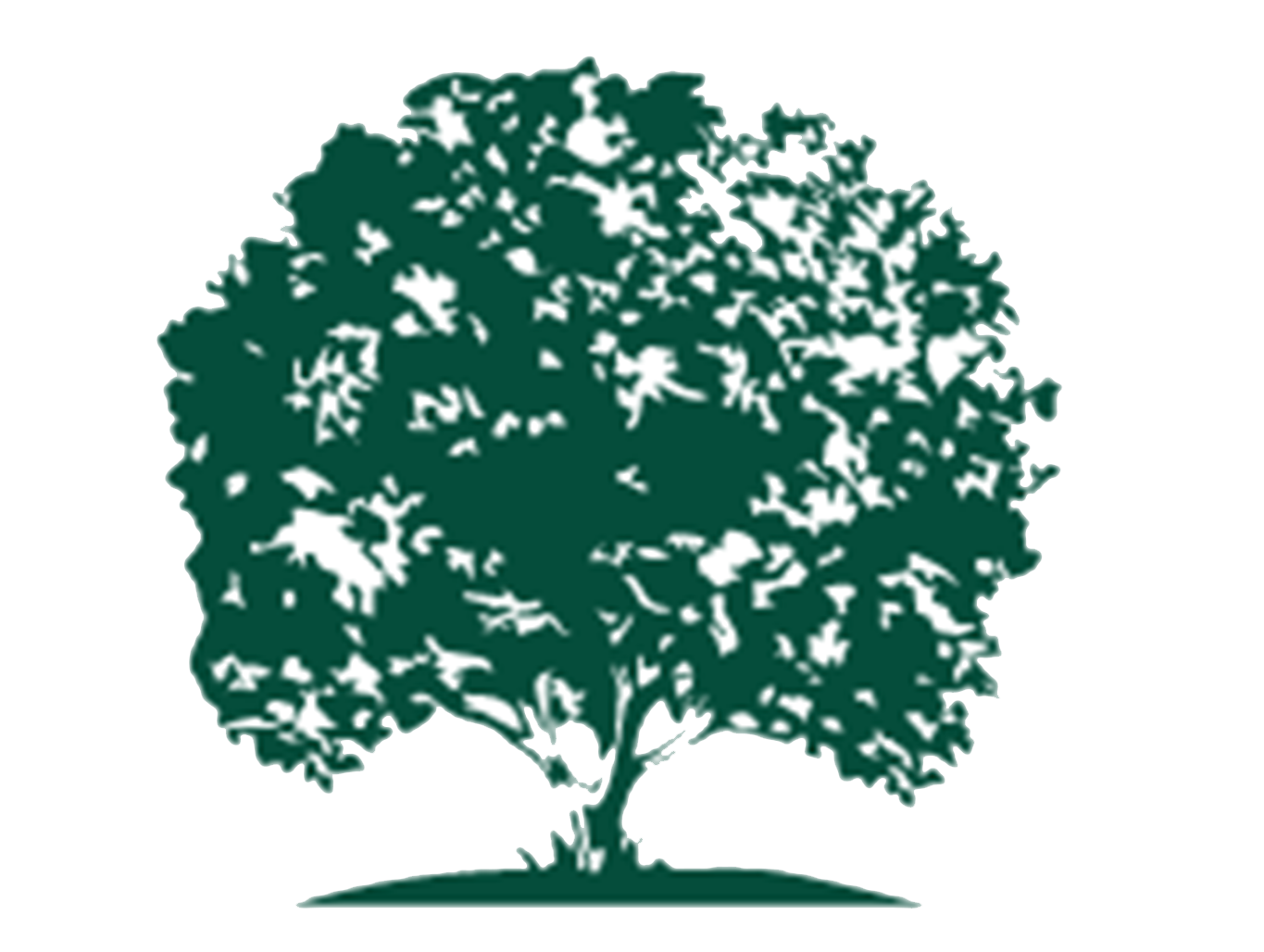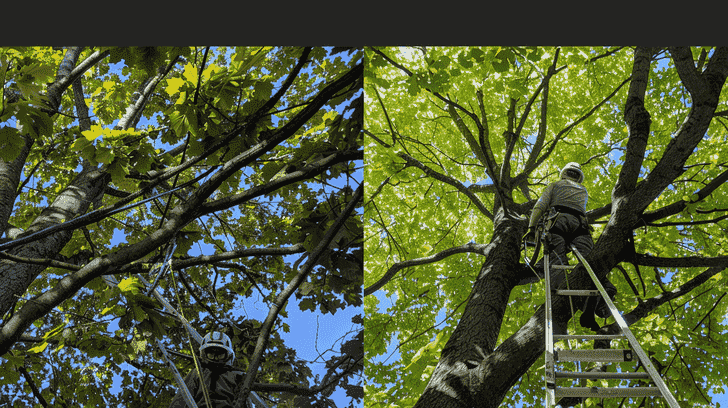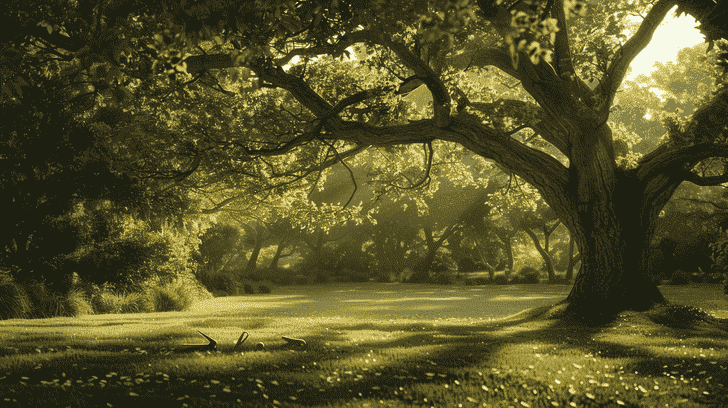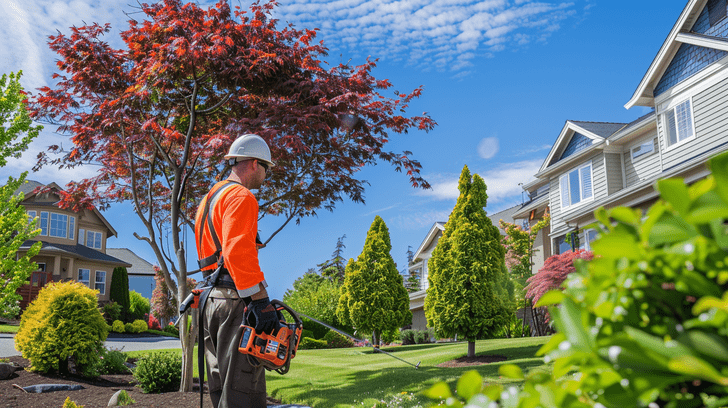Essential Guide to Pruning Large Maple Trees
Pruning large maple trees involves the careful removal of branches to promote tree health, growth, and aesthetics.
This process requires expertise to ensure the proper timing, technique, and tools are used to avoid damaging the tree.
By understanding the anatomy of the tree and following best practices, arborists can effectively shape the canopy, improve air circulation, and reduce the risk of disease or pest infestations.
Properly pruned maple trees not only enhance the overall landscape but also contribute to the longevity and vitality of the tree.
Why Prune Your Maple Tree?
To maintain the essential health of your maple tree, pruning plays a vital role in promoting growth and preventing diseases.
Trimming also enhances the overall appearance of your tree, ensuring it remains visually appealing in your landscape.
Additionally, regular pruning helps eliminate any potential safety hazards, such as weak or overgrown branches, safeguarding your property and loved ones.
Health benefits
Enhancing the overall health and longevity of your maple tree can be achieved through strategic pruning practices. Proper tree pruning plays an essential role in maintaining the health and vitality of your maple tree.
By removing dead or diseased branches, you prevent the spread of infections and diseases, promoting overall tree care.
Trimming back overgrown areas allows for better air circulation and sunlight exposure, leading to improved photosynthesis and nutrient absorption.
This, in turn, boosts the tree’s ability to fight off pests and diseases, ensuring its continued growth and strength.
Regular tree pruning also helps in maintaining a balanced structure, reducing the risk of branches breaking and causing potential harm. Prioritizing tree health through pruning is fundamental for the long-term well-being of your maple tree.
Aesthetic improvements
Pruning your maple tree can greatly enhance its visual appeal and overall aesthetics. When you trim maple trees, you not only maintain their health but also guarantee they look beautiful in your landscape.
Trimming branches to shape the tree helps create a neat and well-maintained appearance. Additionally, trimming them to remove dead or diseased branches not only improves the tree’s health but also prevents potential hazards.
To keep your maples looking their best, regular pruning is essential. Below is a table summarizing the key aesthetic benefits of pruning your maple tree:
| Aesthetic Benefits of Pruning Maple Trees |
| Enhances visual appeal |
| Promotes tree health |
| Shapes the tree structure |
| Removes dead/diseased branches |
| Maintains overall aesthetics |
Safety considerations
When considering the maintenance of your maple tree, it’s important to prioritize safety by addressing potential hazards through strategic pruning practices.
The best time to prune maple trees is during late winter or early spring when they’re still dormant. Safety considerations should always come first, especially when dealing with large trees.
Before starting any pruning, assess the tree for any damaged or weak branches that could pose a risk.
When trimming younger trees, focus on developing a strong central leader and removing any crossing or rubbing branches.
Proper technique is essential to avoid causing harm to the tree or yourself. Remember to use sharp, clean tools and make precise cuts to promote tree health and longevity.
When to Prune Maple Trees
To promote the health and vitality of your maple tree, it’s essential to understand the best seasons for pruning and recognize the signs indicating it’s time to trim.
Knowing when to prune can prevent unnecessary stress on the tree and encourage ideal growth.
Best seasons for pruning
During the dormant winter months, it’s ideal to prune large maple trees to promote healthy growth and structure. The best time to prune maple trees is in late winter or early spring when the tree is still dormant. This period allows the tree to heal efficiently before the active growth season begins.
Avoid pruning during late summer as it can make the tree more susceptible to diseases.
The dormant season offers the advantage of clear visibility of the tree’s structure, making it easier to assess which branches need trimming.
Pruning during this time also reduces the risk of sap bleeding from the wounds.
Signs it’s time to prune
Identifying key indicators that signify the need for pruning your large maple trees is crucial for maintaining their health and structural integrity.
When it comes to pruning older trees like the red maple, there are specific signs to watch for.
Look for dead or diseased branches, as these can spread and harm the rest of the tree.
Additionally, crossing or rubbing branches can cause wounds and affect growth. Keep an eye out for branches that are growing too close to power lines or structures, as these pose a risk.
If you notice any of these signs, it’s time to prune your maple tree. Regular pruning not only safeguards the tree’s health but also enhances its overall appearance and longevity.
How to Prune Large Maple Trees
To properly prune large maple trees, you’ll need specific tools such as pruning shears, loppers, and a pruning saw.
The step-by-step pruning process involves identifying dead or diseased branches, thinning out crowded areas, and shaping the tree for best growth.
Remember to prioritize safety by wearing protective gear, avoiding overhead power lines, and making cuts at the correct angles to promote healthy regrowth.
Tools Needed for Pruning
Make sure you have the appropriate tools on hand before starting the pruning process for large maple trees.
Having the right tools can make the job more manageable and ensure a clean cut that promotes tree health. Below is a list of essential tools for pruning large maple trees:
| Tool | Description |
| Pruning Saw | Used for cutting larger branches efficiently. |
| Loppers | Ideal for cutting branches up to 2 inches in diameter. |
| Shears | Perfect for trimming small twigs and foliage. |
When selecting tools, consider the size of the branches and the precision required. If unsure, consulting with an arborist can provide guidance on the best tools to use.
Remember to always cut just outside the branch collar to aid in the healing process and prevent damage to the tree.
Step-by-Step Pruning Process
Begin the pruning process by evaluating the overall health and structure of the large maple tree to determine which branches need to be pruned for best growth and longevity.
Inspect the maple tree during the dormant season to identify dead, diseased, or crossing branches that could hinder the tree’s development.
When pruning, focus on maintaining the tree’s natural shape and thinning out crowded areas within the canopy to allow for better air circulation and sunlight penetration.
Always use sharp, clean tools to make precise cuts just outside the branch collar without leaving stubs.
Proper pruning techniques can promote new growth, reduce the risk of diseases, and enhance the overall health and beauty of your maple tree.
Safety Tips for Pruning
Assess the surroundings before starting the pruning process on large maple trees in order to guarantee a safe working environment for both you and the tree.
When trimming a maple tree, prioritize safety by wearing proper gear such as gloves, goggles, and sturdy footwear.
Make sure all tools are sharp to make clean cuts, reducing the risk of tearing the bark.
Before cutting a maple tree back, inspect for any signs of damage or disease, as these areas may contain excess sap that can be sticky and affect your grip.
Be cautious of winter conditions, as ice or snow can make the ground slippery and branches more brittle. Always have a clear exit strategy in case a branch shifts unexpectedly.
Professional vs. DIY Pruning
When considering professional versus DIY pruning for large maple trees, it’s important to know when to call a professional for complex or high-risk tasks.
However, if you’re confident in your skills and equipped with the right tools, DIY pruning can be a cost-effective option.
Remember to always follow safety protocols and research proper techniques before undertaking any pruning project on your own.
When to call a professional
Consider engaging a professional arborist for pruning large maple trees, especially if the task requires specialized equipment or expertise beyond your capabilities.
When to call a professional:
- Complex Tree Structure: If your maple tree has intricate branching patterns or is near power lines.
- Diseased Trees: When dealing with diseased or pest-infested maple trees to make sure proper removal and disposal.
- Safety Concerns: In situations where pruning involves climbing tall trees or using heavy machinery, prioritizing safety is essential.
Calling a professional ensures the health and aesthetics of your maple tree are maintained without risking damage or injury.
Professional arborists possess the knowledge and tools necessary to tackle challenging pruning tasks effectively.
Tips for DIY pruning
Evaluate the size and condition of your maple tree before deciding between professional or DIY pruning methods for best results.
When opting for DIY pruning, start by trimming lower branches that obstruct walkways or structures. Use sharp, clean tools to make precise cuts and prevent damage to the tree.
Remember to remove dead or diseased branches to promote healthy growth and improve the overall appearance of your maple tree.
Additionally, thin out dense foliage to enhance air circulation and sunlight penetration. Be cautious not to over-prune, as this can stress the tree.
Regularly inspect your maple tree to address any pruning needs promptly and maintain its health and structure.
Aftercare for Pruned Maple Trees
After pruning your large maple trees, it’s important to focus on post-pruning tree care to guarantee the best recovery and growth.
This includes monitoring the tree’s health and progress closely, addressing any signs of stress or damage promptly.
Regular maintenance such as watering, fertilizing, and protecting the tree from pests or diseases is essential for long-term tree health and vitality.
Post-pruning tree care
Implementing proper post-pruning tree care for large maple trees involves consistent monitoring of new growth patterns and timely removal of any dead or diseased branches to maintain tree health and vigor.
To guarantee the health and beauty of your maple trees, follow these essential steps:
- Watering: Keep the soil around the tree moist but not waterlogged to support recovery.
- Mulching: Apply a layer of organic mulch around the base of the tree to retain moisture and regulate soil temperature.
- Fertilizing: Use a balanced fertilizer to provide essential nutrients for robust growth and recovery.
Monitoring and maintenance
To maintain the health and vitality of pruned maple trees, diligent monitoring and regular maintenance are essential components in ensuring their continued well-being and growth.
After pruning, it’s important to monitor the tree regularly to assess its response to the pruning process.
Keep a close eye on the branches for any signs of stress, disease, or pest infestations.
Conduct routine maintenance tasks such as watering, mulching, and fertilizing as needed to support the tree’s recovery and promote new growth.
Pruning cuts should also be monitored for proper healing and to prevent any potential issues.
FAQ
Should mature maple trees be pruned?
Pruning mature maple trees is essential for maintaining their health and structural integrity. When it comes to mature maple trees, pruning should be done carefully and purposefully. Here are some key points to keep in mind:
- Prune away dead branches: Removing dead branches not only improves the tree’s appearance but also prevents the spread of diseases.
- Keep the tree healthy: Regular pruning promotes overall tree health by allowing better air circulation and sunlight penetration.
- Thin out dense canopies: Thinning out the canopy of a mature maple tree helps reduce weight on branches, decreasing the risk of breakage.
How do you trim a large maple tree?
When trimming a large maple tree, focus on strategic pruning techniques to maintain the tree’s health and structural integrity.
Start by removing any dead, diseased, or damaged branches to promote new growth and prevent potential hazards. Trim branches that cross or rub against each other to prevent bark damage and encourage a strong framework.
When dealing with a large maple tree, consider the tree’s natural shape and growth pattern to determine which branches need pruning. It’s essential to trim the branches properly, making clean cuts just outside the branch collar without leaving stubs.
For a young tree, focus on training it by pruning to create a sturdy and well-balanced structure that will support healthy growth in the future.
Should I cut the top off my maple tree?
Is it advisable to remove the top of your maple tree for any reason?
When contemplating the option to cut the top off a large maple tree, it’s essential to proceed with caution to guarantee the tree’s health and aesthetics are maintained. Here are some vital points to ponder:
- Impact on Tree Health: Removing the top of a maple tree can cause stress and potentially harm its overall health.
- Aesthetic Considerations: Drastic pruning, such as cutting the top off, can notably alter the tree’s appearance.
- Branch Growth: Cutting the top off may lead to vigorous branching below the cut, affecting the tree’s natural form and balance.
Always consult with a professional arborist before deciding to cut the top off your large maple tree to secure the best outcome for the tree’s health and longevity.
How do you reduce the size of a maple tree?
Reducing the size of a maple tree involves selectively pruning branches to maintain its shape and structure.
When dealing with large maple trees, it’s important to target weak branches, which may be causing the tree to appear overgrown or unbalanced.
To reduce the size effectively, start by identifying the branches that need trimming to reshape the tree.
Prune back these branches carefully, making clean cuts near the branch collar to promote healing and prevent disease.
By shaping the tree through strategic pruning, you not only control its size but also encourage healthier growth patterns.
Remember to regularly inspect and prune your large maple tree to maintain its size and overall appearance.







